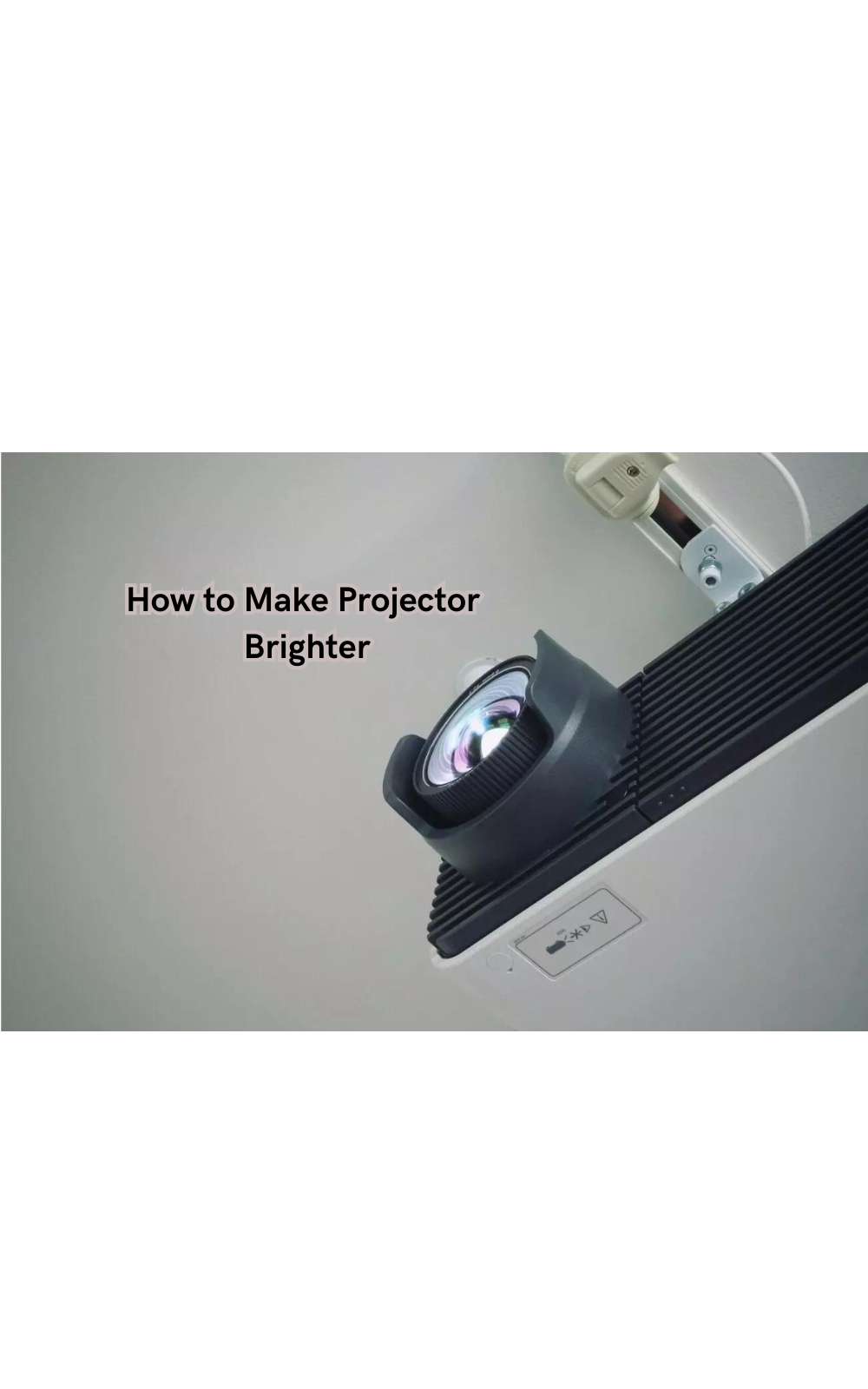How to Make Projector Brighter
In this post, we will explore practical tips and techniques to enhance your projector’s brightness.

When it comes to enjoying movies, presentations, or gaming, a bright projector is essential for a crisp and vivid viewing experience.
However, many users face the frustrating issue of dim projections, which can detract from the overall enjoyment and clarity of the content. Common culprits include incorrect settings, poor environmental conditions, and lack of maintenance.
In this post, we will explore practical tips and techniques to enhance your projector’s brightness. From adjusting settings and optimizing your viewing environment to regular maintenance, we’ll guide you through simple steps to achieve a brighter, more enjoyable projection. Stay tuned to transform your viewing experience and make the most out of your projector.
Why Projector Brightness Matter
Projector brightness is an essential aspect of the overall viewing experience. It not only affects image quality but also determines the clarity and level of detail in the displayed content.
A bright projector can make a significant difference, especially when viewing in rooms with ambient light or during daylight hours. In these conditions, a dull projection may appear washed out, making it challenging to see finer details or colors accurately. This can be frustrating and significantly impact your overall enjoyment of the content being displayed.
Moreover, a brighter projector can also enhance contrast levels, resulting in sharper images and more vivid colors. This is particularly beneficial for watching movies or playing games that require a high level of visual detail and immersion.
In addition, projectors with high brightness levels are ideal for larger screens and bigger audiences. With a brighter projector, you can project onto a larger screen or in front of more people without sacrificing image quality or clarity.
Therefore, it is crucial to make sure your projector's brightness is optimized for the best viewing experience. In the following sections, we will discuss different ways to achieve this and improve your overall projection quality.
Factors That Affect Projector Brightness
Lets find out some common factors that can cause a projector to appear dim. Identifying and addressing these issues can help improve your projector's brightness.
Ambient Light
One of the most significant factors that can impact projector brightness is ambient light. Natural or artificial light sources in a room can greatly affect how your projection looks on screen. The more ambient light present, the harder it becomes to see the projected image clearly.
To achieve the brightest projection possible, try to reduce as much ambient light as possible.
This can be done by dimming or turning off all surrounding lights and closing curtains or blinds to block out natural light from windows. A dark viewing environment will help enhance contrast levels and make the projected image appear brighter.
Projection Surface
The surface onto which you are projecting also plays a crucial role in determining brightness levels.
For optimal brightness, choose a smooth, flat surface with a light-colored finish. A white or neutral-colored wall is considered ideal, as it reflects the projector's light evenly and helps create a brighter image.
Avoid projecting onto dark or textured surfaces, such as brick walls or textured wallpaper, as they can absorb light and make the projection appear dimmer.
If your preferred projection surface is not suitable for bright projections, consider investing in a portable screen specifically designed for projectors. These screens are often made of materials that reflect light better and can help improve brightness levels significantly.
Color Mode and Settings
Projectors come with various color modes and settings that can impact brightness levels. Most projectors have preset modes, such as "cinema" or "presentation," that are optimized for specific types of content. These modes often adjust color and contrast levels to enhance the viewing experience.
However, some projector settings may lead to a dimmer projection due to lower brightness levels. If you notice your projection is not as bright as desired, try adjusting the color mode or individual settings like contrast, gamma, or brightness. Experimenting with different options can help you find the ideal balance between brightness and image quality for your viewing needs.
Projection Distance
The distance between the projector and the screen or surface can also affect brightness levels. The farther away the projector is from the projection surface, the dimmer the image may appear. This is because as the light travels a longer distance, it becomes less intense.
To achieve optimal brightness, place your projector at a distance recommended by the manufacturer for your specific model. This information can usually be found in your projector's user manual.
Lamp or Bulb Age
Another important factor to consider is the age of your projector's lamp or bulb. As these light sources age, they gradually lose their brightness and need to be replaced periodically. Most projectors have a built-in timer that alerts you when it's time to replace the lamp or bulb, but it's always best to keep track of how long you've been using it.
If your projection appears dim and all other factors seem to check out, consider replacing the lamp or bulb with a new one. This can significantly improve brightness levels and give your projector a new life.
Lamp Settings
In addition to the age of your lamp or bulb, its settings can also affect projector brightness. Many projectors have different lamp modes that control brightness levels. For example, a "low" lamp mode may be dimmer but can extend the life of the lamp or bulb, while a "high" mode will provide maximum brightness at the cost of a shorter lifespan.
Check your projector's settings and experiment with different lamp modes to find the optimal balance between brightness and longevity. Keep in mind that using high lamp modes for extended periods may lead to overheating and damage the projector, so use them sparingly when necessary.
How to Make Projector Brighter
Now that we've discussed the factors that can affect projector brightness, let's explore some practical ways to make your projector appear brighter.
Clean Your Lens and Filter
Over time, dust and dirt can accumulate on your projector's lens and filter, reducing the amount of light passing through them. This can greatly impact brightness levels and image quality. Regularly cleaning these components with a soft cloth or compressed air can help improve projected brightness significantly.
Adjust Keystone Correction
Some projectors have keystone correction features that adjust the projected image to prevent distortion caused by projecting from an angle. However, using this feature may also result in decreased brightness levels. If you don't need keystone correction, try turning it off to see if there is a noticeable difference in brightness.
Use High-Quality Cables
The cables you use to connect your projector to your device can also affect brightness levels. Using high-quality HDMI or VGA cables with good shielding can help minimize signal loss and improve the overall projection quality.
Utilize Eco Mode
Many projectors come with an "Eco Mode" option that reduces brightness levels for energy-saving purposes. While this may be beneficial for longer lamp life, it can also cause projections to appear dimmer. Consider using this mode only when necessary and switching back to normal mode for brighter projections.
Manually Increase the Brightness
If all else fails, you can always manually increase the brightness level on your projector. However, keep in mind that this may also result in a shortened lamp or bulb lifespan due to increased power usage. Use this option as a last resort and try to find a balance between brightness and longevity.
These are just a few tips and tricks to help you make your projector appear brighter. Remember to always follow the manufacturer's recommendations and avoid overusing high lamp modes or manually increasing brightness levels for extended periods to prevent damage to your projector.
Maintenance Tips for Brighter Projections
Proper maintenance of your projector can also help maintain and improve its brightness levels over time. Here are some tips to help you keep your projector in top condition:
- Regularly clean the lens and filter.
- Keep the projector away from dust, humidity, and extreme temperatures.
- Use a surge protector to protect against power surges.
- Follow recommended lamp or bulb replacement schedules.
- Store the projector in a safe and dry place when not in use.
By following these maintenance tips, you can prolong the life of your projector and ensure optimal brightness levels for years to come.
How Many Lumens is Good for a Projector?
The brightness of a projector is measured in lumens, and the optimal amount may vary depending on your individual needs. In general, the higher the lumens, the brighter the projection will appear. Here are some recommended lumen levels for different types of environments:
- 1000-1500 lumens: suitable for dimly lit rooms or small spaces like offices or classrooms.
- 2000-3000 lumens: ideal for medium to large conference rooms or home theaters with some ambient light.
- 3500+ lumens: perfect for large venues like auditoriums or outdoor events where there is more ambient light present.
Keep in mind that these are just general guidelines, and you may need to adjust the lumens based on your specific needs and preferences.
FAQs
How can I increase my projector's light output for a brighter image?
To increase your projector's light output, adjust the brightness settings on your projector. Ensuring the projector lens is clean and correctly focused can also help maximize the light emitted from your specific projector model.
Can the type of projector screen affect brightness?
Yes, the type of projector screen can significantly affect brightness. A high-gain projector screen can reflect more light, enhancing the projector's light output and making the image appear brighter.
How do projector lens adjustments impact brightness?
Projector lens adjustments, such as focusing and zooming, can impact the brightness of the image. Properly adjusting the lens ensures that the light emitted is concentrated, maximizing the projector's light output on the screen.
Are there specific brightness settings to improve the projector's light output?
Yes, most projectors have brightness settings that can be adjusted to improve light output. Increasing the brightness level within your projector model’s settings can help make the image clearer and more vibrant on the projector screen.
Conclusion
In conclusion, achieving a brighter projector display involves a combination of adjusting settings, optimizing your environment, and performing regular maintenance.
By fine-tuning brightness, contrast, and color settings, managing room lighting, using a high-quality screen, and ensuring proper projector care, you can significantly enhance your viewing experience. Remember, a well-maintained projector not only delivers better brightness but also prolongs its lifespan.
We hope these tips help you make the most out of your projector. Feel free to share your own experiences or additional tips in the comments section below. Together, we can ensure everyone enjoys the best possible projection quality. Happy viewing!
